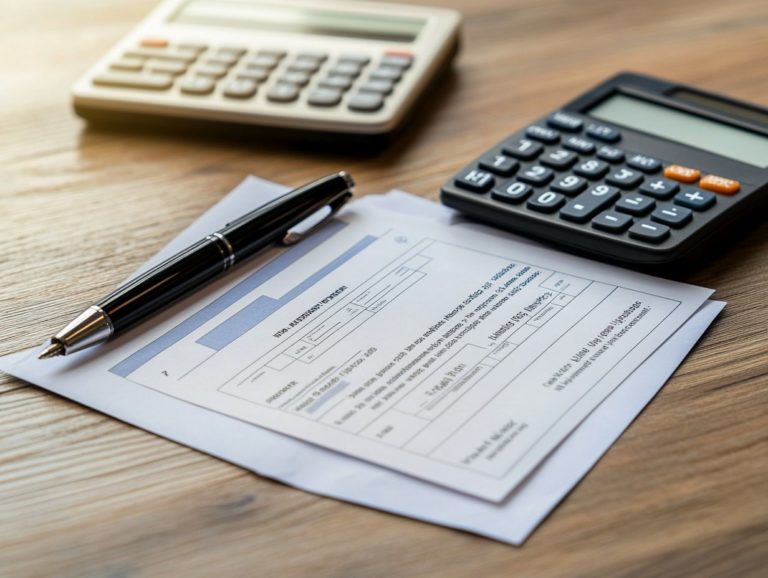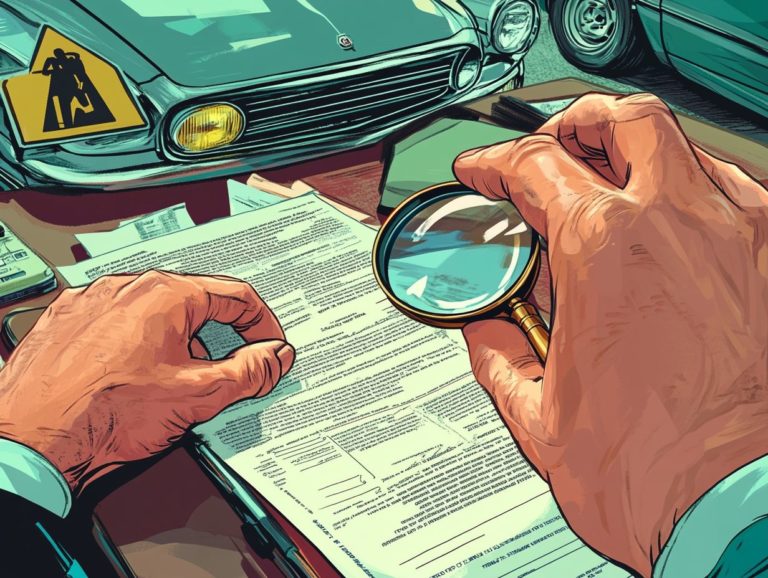Essential Tips for First-Time Car Leasees
Leasing a car offers an exceptional blend of flexibility and access to the latest models, all without the long-term commitment that comes with purchasing. For first-time lessees, the intricacies of leasing can seem daunting. This guide is designed to demystify the process, breaking down essential tips that will enable you to make informed decisions everything from deciphering lease agreements to mastering your budget.
Whether you’re considering your very first vehicle or simply looking for a refresher, these insights will empower you to approach leasing with confidence and clarity.
Contents
- Key Takeaways:
- 1. Understand the Basics of Car Leasing
- 2. Know Your Budget and Stick to It
- 3. Research the Best Deals and Negotiate
- 4. Read and Understand the Lease Agreement
- 5. Take a Test Drive Before Making a Decision
- 6. Consider the Resale Value of the Car
- 7. Don’t Forget About Insurance
- 8. Keep Track of Maintenance and Repairs
- 9. Understand the Mileage Limitations
- 10. Know Your Options at the End of the Lease
- 11. Consider Gap Insurance
- 12. Be Aware of Hidden Fees and Charges
- 13. Don’t Be Afraid to Walk Away
- 14. Take Advantage of Incentives and Special Offers
- 15. Stay Informed and Updated on Car Leasing Trends
- Frequently Asked Questions
Key Takeaways:

- Understand the basics of car leasing to make an informed decision.
- Stick to your budget by researching and negotiating the best deals.
- Thoroughly read and understand the lease agreement before signing.
1. Understand the Basics of Car Leasing
Understanding the basics of car leasing is crucial for anyone considering this option. It involves specific terms and concepts that can significantly influence your financial experience throughout the leasing process, such as lease contracts and total costs.
Leasing is an exciting opportunity to drive a new car without the long-term commitment that comes with ownership. It’s important to distinguish between leasing and purchasing a vehicle, as each choice carries its own financial implications.
For example, while a lease generally results in lower monthly payments, you may encounter mileage restrictions and end-of-lease fees. Closed-end leases, which are quite common, permit you to return the vehicle without the worry of its future value also known as residual value. Understanding these elements is key to estimating the total cost of leasing a car and finding the option that best aligns with your lifestyle and budget.
2. Know Your Budget and Stick to It
Establishing a clear budget is essential when leasing a car, as it helps you pinpoint your monthly payment limits and grasp the capitalized cost tied to the lease. This foresight ensures you sidestep any financial strain throughout the lease term.
To effectively calculate this budget, consider not just the monthly payment but also potential maintenance costs and leasing fees these can accumulate more quickly than you might anticipate. Evaluate the mileage allowances and any wear-and-tear clauses in the lease agreement, as these could lead to unexpected charges at the end of your lease.
Setting aside a portion of your income for insurance, fuel, and registration fees gives you a more realistic financial outlook. By doing this, you can craft a comprehensive financial plan that encompasses all aspects of vehicle leasing while still honoring your other essential expenses.
3. Research the Best Deals and Negotiate
Researching the best deals and negotiating effectively with dealerships can unlock substantial savings on your car lease, allowing you to secure favorable terms and potentially lower those monthly payments.
By taking the time to evaluate various auto providers, you can uncover a wealth of offers that might not be immediately obvious. Start by diving into online resources, reading customer reviews, and checking out local dealership promotions to discover competitive lease options.
When you step into dealerships, employing savvy negotiation strategies like discussing the capitalized cost or tweaking payment terms can significantly improve your lease agreement. Engaging with sales representatives while armed with knowledge about current incentives and financing options enables you to advocate for better conditions. For those looking to enhance their skills further, learning how to negotiate your car lease like a pro ultimately translates to a more manageable monthly expenditure for your new vehicle.
Now that you ve explored these key insights, take the next step by researching local leasing options or contacting a dealer. Empower yourself with knowledge and get ready to drive your new vehicle!
4. Read and Understand the Lease Agreement
Reading and understanding your lease agreement is essential. Be sure to fully grasp the terms and conditions governing your car lease, including fine print that could lead to unexpected charges or responsibilities. For a comprehensive overview, check out our guide on understanding new car lease agreements.
Take the time to scrutinize every detail of the lease. Uncover crucial information, such as early termination clauses that might impose hefty penalties and mileage limits that, if exceeded, could result in additional fees. Be aware of hidden costs like disposition fees or maintenance charges, as they significantly shape a budget that accurately reflects your total expenditure.
Maintaining clarity throughout the leasing process protects you against common pitfalls that can lead to financial strain. Don’t hesitate to ask questions to clarify any unclear terms before you sign on the dotted line.
5. Take a Test Drive Before Making a Decision

Taking a test drive is a crucial step in your car leasing journey. It allows you to explore various vehicle types and find the one that truly resonates with your driving habits and preferences before learning how to prepare for new car ownership and sealing the lease agreement.
This hands-on experience is crucial for assessing comfort, performance, and the unique features each car offers. By getting behind the wheel of several models, assess how each one feels everything from the grip of the steering wheel to the engine’s responsiveness.
Reflect on how each vehicle fits into your lifestyle, whether for daily commutes, adventurous weekend road trips, or cherished family outings.
Exploring dealership offers can reveal more favorable leasing terms. This transforms your decision-making process into a blend of personal preference and practical value.
6. Consider the Resale Value of the Car
Considering the resale value of a car is essential when leasing. It impacts the value left after leasing and indicates how much the vehicle will depreciate during the lease term.
Different car models show significant variations in resale values, largely shaped by brand reputation and current market demand. For instance, luxury brands typically retain higher resale values compared to economy models, making them appealing for leasing.
Understanding vehicle depreciation is not just about future planning; it plays a crucial role in determining your lease payments. A car with lower depreciation can lead to more attractive monthly payments, while higher depreciation might increase your costs.
By grasping these dynamics, make informed decisions at the end of your lease. Decide whether to buy the vehicle or explore new leasing opportunities.
7. Don’t Forget About Insurance
Car insurance is an essential element of vehicle leasing. Grasping the necessary coverage is crucial for complying with leasing terms while safeguarding your financial investment.
When you lease a vehicle, the leasing company sets specific insurance requirements that you must meet. This typically includes comprehensive and collision coverage, with limits that may exceed standard requirements to adequately cover the vehicle’s value.
Considering GAP insurance is wise. It covers the difference between what you owe on the lease and the car s actual cash value in the event of a total loss. Factor these insurance costs into your overall leasing expenses, as they significantly influence your monthly payments and financial obligations.
Maintaining proper insurance fulfills a contractual requirement and grants you peace of mind throughout the lease term.
8. Keep Track of Maintenance and Repairs
Keeping track of maintenance and repairs during your lease is essential. Follow the maintenance schedule to avoid high fees and keep your car in excellent condition.
Regular upkeep preserves value and meets the leasing agreement. Neglecting services can lead to penalties and unexpected costs.
During end-of-lease evaluations, your car’s condition will be closely examined. Staying proactive with maintenance can help you avoid costly repairs and ensure a smoother transition back to the leasing company.
9. Understand the Mileage Limitations
Understanding mileage limitations is crucial when leasing. Exceeding the mileage cap can lead to significant penalties.
Typically, caps range from 10,000 to 15,000 miles per year. If you travel often, these limits may feel restrictive.
To avoid hefty fees at lease end, monitor your driving habits. Planning ahead and choosing a vehicle with a higher mileage allowance can help you manage mileage.
10. Know Your Options at the End of the Lease

Understanding your options at the end of the lease is crucial. Whether you consider a lease buyout this means buying the car at the end of the lease or returning the car, knowledge is key.
Weigh the pros and cons carefully. A lease buyout requires paying the residual value, which can affect your finances. Be cautious with early termination it could lead to surprising costs.
Knowing your needs like driving habits and budget guides your choice. Take time to analyze these factors for smarter financial choices and a better automotive experience.
11. Consider Gap Insurance
Considering gap insurance is essential when you lease a car. It covers the difference between what you owe and the car’s cash value if it’s a total loss.
This insurance acts as your safety net, preventing unexpected costs. It s especially crucial if you need to terminate the lease early.
Having gap insurance eases worries about financial pitfalls. It gives you peace of mind to enjoy your leased vehicle without fear of being underinsured.
12. Be Aware of Hidden Fees and Charges
Being aware of hidden fees and charges is essential when leasing a car. These unexpected costs can significantly inflate your overall expenses and create misunderstandings about the true financial implications of your lease agreement.
Among the most common culprits are disposition fees. These are costs you may need to pay when you return the vehicle at the end of your lease. Another common charge is excessive mileage charges, which can quickly pile up if you exceed the mileage limit outlined in your contract. These additional costs can easily catch you off guard if you haven t scrutinized the fine print.
It s crucial for you to thoroughly review your leasing agreements. Ensure that you fully comprehend the terms and conditions. This diligence will help you avoid surprises at the end of the lease term and allow you to navigate the process with greater awareness. You can then make more financially sound decisions.
13. Don’t Be Afraid to Walk Away
Don’t hesitate to walk away from a leasing deal if the terms fall short of your expectations. That assertiveness can pave the way for better negotiations with dealerships, ultimately leading to more favorable leasing terms down the line.
Many people underestimate the sheer power of saying no. When you do, you create leverage that can prompt dealers to present more enticing options. It’s crucial for you to remain aware of your budget constraints and credit score throughout this process.
By keeping these key factors in mind, you not only maintain your financial stability but also strengthen your position during negotiations. Recognizing when to pivot or step back can truly make a difference in securing a leasing agreement that aligns perfectly with your financial goals and requirements.
14. Take Advantage of Incentives and Special Offers
Taking advantage of incentives and special offers can truly elevate your leasing experience. This allows you to secure better terms and potentially lower your overall costs.
Dealerships and manufacturers roll out a range of enticing incentives, such as cashback offers, reduced interest rates, and promotional lease agreements. These offers can significantly impact your monthly payments and reduce your down payment, making that high-quality vehicle you desire much more attainable.
Seasonal promotions and loyalty programs can further enhance your leasing conditions. It s wise to take the time to research what s available in your area. Actively ask about any special offers during the leasing process. By doing so, you ensure that you don t miss out on valuable opportunities to save!
15. Stay Informed and Updated on Car Leasing Trends

Staying informed about current car leasing trends can provide you with a significant advantage in the leasing process. This enables you to uncover the best deals and grasp shifts in the auto financing landscape.
By regularly following industry news, you can identify emerging market trends that could directly affect leasing agreements and payment terms. For example, as consumer preferences change and manufacturers roll out new models, some vehicles may become more accessible or desirable. This alters their leasing availability.
Fluctuations in interest rates or economic conditions can also lead to variations in monthly payments. It’s crucial for anyone involved in car leasing to remain proactive and attuned to these developments. This knowledge not only enhances your decision-making capabilities but also strengthens your negotiating position when entering into leases.
Frequently Asked Questions
- What is a car lease?
- A car lease is a type of financing agreement that allows individuals to use a vehicle for an agreed-upon period of time by paying a fixed monthly fee. At the end of the lease, the car is returned to the leasing company.
- Why should I consider leasing a car?
- Leasing a car can have financial benefits such as lower monthly payments, a lower down payment and sales tax, and the ability to drive a new car every few years. It also allows you to avoid the hassle of selling or trading in a car.
Essential Tips for First-Time Car Leasees
1. Research car models that fit your needs and budget.
2. Negotiate the lease terms, including the price, mileage, and fees. Aim for the best deal!
3. Understand your lease contract. This helps avoid surprises or hidden fees.
4. Think about getting gap insurance. It covers the difference between the car’s value and remaining lease payments if there’s an accident.
5. Take good care of the car. This helps you avoid extra fees for wear and tear.
6. Plan early for the end of your lease. This helps you avoid last-minute decisions or charges.
Types of Car Leases
There are two main types of car leases: closed-end and open-end leases.
In a closed-end lease, you can return the car and walk away when the lease ends. With an open-end lease, you pay any difference between the car’s value and its market value at the lease’s end.
Can I Negotiate My Lease Terms?
Yes! You can negotiate the price, mileage, and fees of your car lease, just like buying a car. Do your research and be ready to walk away if the terms aren t right.
What Happens at the End of a Car Lease?
At the end of your lease, you have options: return the car, buy it at the agreed price, or lease or buy a new car.
Plan ahead! Understand your choices to make the best decision for your situation.






